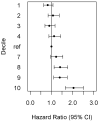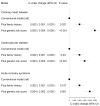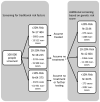Genetic risk prediction and a 2-stage risk screening strategy for coronary heart disease
- PMID: 23599444
- PMCID: PMC4210840
- DOI: 10.1161/ATVBAHA.112.301120
Genetic risk prediction and a 2-stage risk screening strategy for coronary heart disease
Abstract
Objective: Genome-wide association studies have identified several genetic variants associated with coronary heart disease (CHD). The aim of this study was to evaluate the genetic risk discrimination and reclassification and apply the results for a 2-stage population risk screening strategy for CHD.
Approach and results: We genotyped 28 genetic variants in 24 124 participants in 4 Finnish population-based, prospective cohorts (recruitment years 1992-2002). We constructed a multilocus genetic risk score and evaluated its association with incident cardiovascular disease events. During the median follow-up time of 12 years (interquartile range 8.75-15.25 years), we observed 1093 CHD, 1552 cardiovascular disease, and 731 acute coronary syndrome events. Adding genetic information to conventional risk factors and family history improved risk discrimination of CHD (C-index 0.856 versus 0.851; P=0.0002) and other end points (cardiovascular disease: C-index 0.840 versus 0.837, P=0.0004; acute coronary syndrome: C-index 0.859 versus 0.855, P=0.001). In a standard population of 100 000 individuals, additional genetic screening of subjects at intermediate risk for CHD would reclassify 2144 subjects (12%) into high-risk category. Statin allocation for these subjects is estimated to prevent 135 CHD cases over 14 years. Similar results were obtained by external validation, where the effects were estimated from a training data set and applied for a test data set.
Conclusions: Genetic risk score improves risk prediction of CHD and helps to identify individuals at high risk for the first CHD event. Genetic screening for individuals at intermediate cardiovascular risk could help to prevent future cases through better targeting of statins.
Keywords: cardiovascular genomics; genetic association; genetic epidemiology; risk factor; risk prediction.
Figures



Comment in
-
Genomic medicine for improved prediction and primordial prevention of cardiovascular disease.Arterioscler Thromb Vasc Biol. 2013 Sep;33(9):2049-50. doi: 10.1161/ATVBAHA.113.301814. Arterioscler Thromb Vasc Biol. 2013. PMID: 23946465 Free PMC article. No abstract available.
References
-
- Musunuru K, Kathiresan S. Genetics of coronary artery disease. Annu Rev Genomics Hum Genet. 2011;11:91–108. - PubMed
-
- Coronary Artery Disease (C4D) Genetics Consortium A genome-wide association study in Europeans and South Asians identifies five new loci for coronary artery disease. Nat Genet. 2011;43:339–344. - PubMed
-
- Thanassoulis G, Peloso GM, Pencina MJ, Hoffmann U, Fox CS, Cupples LA, Levy D, D’Agostino RB, Hwang SJ, O’Donnell CJ. A genetic risk score is associated with incident cardiovascular disease and coronary artery calcium: the Framingham Heart Study. Circ Cardiovasc Genet. 2012;5:113–121. - PMC - PubMed
MATERIAL AND METHODS REFERENCES
-
- Vartiainen E, Laatikainen T, Peltonen M, Juolevi A, Mannisto S, Sundvall J, Jousilahti P, Salomaa V, Valsta L, Puska P. Thirty-five-year trends in cardiovascular risk factors in Finland. Int J Epidemiol. 2010;39:504–518. - PubMed
-
- Kattainen A, Salomaa V, Harkanen T, Jula A, Kaaja R, Kesaniemi YA, Kahonen M, Moilanen L, Nieminen MS, Aromaa A, Reunanen A. Coronary heart disease: from a disease of middle-aged men in the late 1970s to a disease of elderly women in the 2000s. Eur Heart J. 2006;27:296–301. - PubMed
-
- National Public Health Institute Methodology report. Health 2000 survey. http://www.terveys2000.fi/doc/methodologyrep.pdf.
-
- Mähönen M, Jula A, Harald K, Antikainen R, Tuomilehto J, Zeller T, Blankenberg S, Salomaa V. The validity of heart failure diagnoses obtained from administrative registers. Eur J Prev Cardiol. 2013;20:254–259. - PubMed
-
- Pajunen P, Koukkunen H, Ketonen M, et al. The validity of the Finnish Hospital Discharge Register and Causes of Death Register data on coronary heart disease. Eur J Cardiovasc Prev Rehabil. 2005;12:132–137. - PubMed
Publication types
MeSH terms
Substances
Grants and funding
LinkOut - more resources
Full Text Sources
Other Literature Sources
Medical

